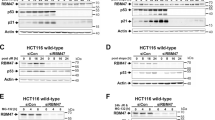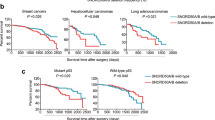Abstract
The RNA helicase p68 is a potent co-activator of p53-dependent transcription in response to DNA damage. Previous independent studies have indicated that p68 and the Δ133p53 isoforms, which modulate the function of full-length p53, are aberrantly expressed in breast cancers. Here we identify a striking inverse association of p68 and Δ133p53 expression in primary breast cancers. Consistent with these findings, small interfering RNA depletion of p68 in cell lines results in a p53-dependant increase of Δ133p53 in response to DNA damage, suggesting that increased Δ133p53 expression could result from downregulation of p68 and provide a potential mechanistic explanation for our observations in breast cancer. Δ133p53α, which has been shown to negatively regulate the function of full-length p53, reciprocally inhibits the ability of p68 to stimulate p53-dependent transcription from the p21 promoter, suggesting that Δ133p53α may be competing with p68 to regulate p53 function. This hypothesis is underscored by our observations that p68 interacts with the C-terminal domain of p53, co-immunoprecipitates 133p53α from cell extracts and interacts only with p53 molecules that are able to form tetramers. These data suggest that p68, p53 and 133p53α may form part of a complex feedback mechanism to regulate the expression of Δ133p53, with consequent modification of p53-mediated transcription, and may modulate the function of p53 in breast and other cancers that harbour wild-type p53.
This is a preview of subscription content, access via your institution
Access options
Subscribe to this journal
Receive 50 print issues and online access
$259.00 per year
only $5.18 per issue
Buy this article
- Purchase on Springer Link
- Instant access to full article PDF
Prices may be subject to local taxes which are calculated during checkout






Similar content being viewed by others
References
Avery-Kiejda KA, Zhang XD, Adams LJ, Scott RJ, Vojtesek B, Lane DP et al. (2008). Small molecular weight variants of p53 are expressed in human melanoma cells and are induced by the DNA-damaging agent cisplatin. Clin Cancer Res 14: 1659–1668.
Balakrishnan SK, Gross DS . (2008). The tumor suppressor p53 associates with gene coding regions and co-traverses with elongating RNA polymerase II in an in vivo model. Oncogene 27: 2661–2672.
Bates GJ, Nicol SM, Wilson BJ, Jacobs AM, Bourdon JC, Wardrop J et al. (2005). The DEAD box protein p68: a novel transcriptional coactivator of the p53 tumour suppressor. EMBO J 24: 543–553.
Bertheau P, Espie M, Turpin E, Lehmann J, Plassa LF, Varna M et al. (2008). TP53 status and response to chemotherapy in breast cancer. Pathobiology 75: 132–139.
Boldrup L, Bourdon JC, Coates PJ, Sjostrom B, Nylander K . (2007). Expression of p53 isoforms in squamous cell carcinoma of the head and neck. Eur J Cancer 43: 617–623.
Bond AT, Mangus DA, He F, Jacobson A . (2001). Absence of Dbp2p alters both nonsense-mediated mRNA decay and rRNA processing. Mol Cell Biol 21: 7366–7379.
Bourdon JC, Fernandes K, Murray-Zmijewski F, Liu G, Diot A, Xirodimas DP et al. (2005). p53 isoforms can regulate p53 transcriptional activity. Genes Dev 19: 2122–2137.
Bunz F, Dutriaux A, Lengauer C, Waldman T, Zhou S, Brown JP et al. (1998). Requirement for p53 and p21 to sustain G2 arrest after DNA damage. Science 282: 1497–1501.
Caretti G, Lei EP, Sartorelli V . (2007). The DEAD-box p68/p72 proteins and the noncoding RNA steroid receptor activator SRA: eclectic regulators of disparate biological functions. Cell Cycle 6: 1172–1176.
Caretti G, Schiltz RL, Dilworth FJ, Di Padova M, Zhao P, Ogryzko V et al. (2006). The RNA helicases p68/p72 and the noncoding RNA SRA are coregulators of MyoD and skeletal muscle differentiation. Dev Cell 11: 547–560.
Carter S, Vousden KH . (2009). Modifications of p53: competing for the lysines. Curr Opin Genet Dev 19: 18–24.
Causevic M, Hislop RG, Kernohan NM, Carey FA, Kay RA, Steele RJ et al. (2001). Overexpression and poly-ubiquitylation of the DEAD-box RNA helicase p68 in colorectal tumours. Oncogene 20: 7734–7743.
Chen J, Ng SM, Chang C, Zhang Z, Bourdon JC, Lane DP et al. (2009). p53 isoform delta113p53 is a p53 target gene that antagonizes p53 apoptotic activity via BclxL activation in zebrafish. Genes Dev 23: 278–290.
Clark EL, Coulson A, Dalgliesh C, Rajan P, Nicol SM, Fleming S et al. (2008). The RNA helicase p68 is a novel androgen receptor coactivator involved in splicing and is overexpressed in prostate cancer. Cancer Res 68: 7938–7946.
Courtois S, Verhaegh G, North S, Luciani MG, Lassus P, Hibner U et al. (2002). DeltaN-p53, a natural isoform of p53 lacking the first transactivation domain, counteracts growth suppression by wild-type p53. Oncogene 21: 6722–6728.
Detre S, Saclani Jotti G, Dowsett M . (1995). A ‘quickscore’ method for immunohistochemical semiquantitation: validation for oestrogen receptor in breast carcinomas. J Clin Pathol 48: 876–878.
el-Deiry WS, Tokino T, Velculescu VE, Levy DB, Parsons R, Trent JM et al. (1993). WAF1, a potential mediator of p53 tumor suppression. Cell 75: 817–825.
Endoh H, Maruyama K, Masuhiro Y, Kobayashi Y, Goto M, Tai H et al. (1999). Purification and identification of p68 RNA helicase acting as a transcriptional coactivator specific for the activation function of human estrogen receptor alpha. Mol Cell Biol 19: 5363–5372.
Fujita K, Mondal AM, Horikawa I, Nguyen GH, Kumamoto K, Sohn JJ et al. (2009). p53 isoforms Delta133p53 and p53beta are endogenous regulators of replicative cellular senescence. Nat Cell Biol 11: 1135–1142.
Fukuda T, Yamagata K, Fujiyama S, Matsumoto T, Koshida I, Yoshimura K et al. (2007). DEAD-box RNA helicase subunits of the Drosha complex are required for processing of rRNA and a subset of microRNAs. Nat Cell Biol 9: 604–611.
Fuller-Pace FV . (2006). DExD/H box RNA helicases: multifunctional proteins with important roles in transcriptional regulation. Nucleic Acids Res 34: 4206–4215.
Graupner V, Schulze-Osthoff K, Essmann F, Janicke RU . (2009). Functional characterization of p53beta and p53gamma, two isoforms of the tumor suppressor p53. Cell Cycle 8: 1238–1248.
Guil S, Gattoni R, Carrascal M, Abian J, Stevenin J, Bach-Elias M . (2003). Roles of hnRNP A1, SR proteins, and p68 helicase in c-H-ras alternative splicing regulation. Mol Cell Biol 23: 2927–2941.
Halazonetis TD, Gorgoulis VG, Bartek J . (2008). An oncogene-induced DNA damage model for cancer development. Science 319: 1352–1355.
Harris SL, Levine AJ . (2005). The p53 pathway: positive and negative feedback loops. Oncogene 24: 2899–2908.
Hsieh JK, Chan FS, O′Connor DJ, Mittnacht S, Zhong S, Lu X . (1999). RB regulates the stability and the apoptotic function of p53 via MDM2. Mol Cell 3: 181–193.
Jensen ED, Niu L, Caretti G, Nicol SM, Teplyuk N, Stein GS et al. (2008). p68 (Ddx5) interacts with Runx2 and regulates osteoblast differentiation. J Cell Biochem 103: 1438–1451.
Liu ZR . (2002). p68 RNA helicase is an essential human splicing factor that acts at the U1 snRNA-5′ splice site duplex. Mol Cell Biol 22: 5443–5450.
Marcel V, Vijayakumar V, Fernandez-Cuesta L, Hafsi H, Sagne C, Hautefeuille A et al. (2010). p53 regulates the transcription of its Delta133p53 isoform through specific response elements contained within the TP53 P2 internal promoter. Oncogene 29: 2691–2700.
Mateu MG, Fersht AR . (1998). Nine hydrophobic side chains are key determinants of the thermodynamic stability and oligomerization status of tumour suppressor p53 tetramerization domain. EMBO J 17: 2748–2758.
Mehta SA, Christopherson KW, Bhat-Nakshatri P, Goulet Jr RJ, Broxmeyer HE, Kopelovich L et al. (2007). Negative regulation of chemokine receptor CXCR4 by tumor suppressor p53 in breast cancer cells: implications of p53 mutation or isoform expression on breast cancer cell invasion. Oncogene 26: 3329–3337.
Murray-Zmijewski F, Lane DP, Bourdon JC . (2006). p53/p63/p73 isoforms: an orchestra of isoforms to harmonise cell differentiation and response to stress. Cell Death Differ 13: 962–972.
Olivier M, Eeles R, Hollstein M, Khan MA, Harris CC, Hainaut P . (2002). The IARC TP53 database: new online mutation analysis and recommendations to users. Hum Mutat 19: 607–614.
Olivier M, Langerod A, Carrieri P, Bergh J, Klaar S, Eyfjord J et al. (2006). The clinical value of somatic TP53 gene mutations in 1,794 patients with breast cancer. Clin Cancer Res 12: 1157–1167.
Petitjean A, Achatz MI, Borresen-Dale AL, Hainaut P, Olivier M . (2007). TP53 mutations in human cancers: functional selection and impact on cancer prognosis and outcomes. Oncogene 26: 2157–2165.
Salzman DW, Shubert-Coleman J, Furneaux H . (2007). P68 RNA helicase unwinds the human let-7 microRNA precursor duplex and is required for let-7-directed silencing of gene expression. J Biol Chem 282: 32773–32779.
Stevenson RJ, Hamilton SJ, MacCallum DE, Hall PA, Fuller-Pace FV . (1998). Expression of the ′dead box′ RNA helicase p68 is developmentally and growth regulated and correlates with organ differentiation/maturation in the fetus. J Pathol 184: 351–359.
Vogelstein B, Lane D, Levine AJ . (2000). Surfing the p53 network. Nature 408: 307–310.
Vousden KH, Lu X . (2002). Live or let die: the cell′s response to p53. Nat Rev Cancer 2: 594–604.
Watanabe M, Yanagisawa J, Kitagawa H, Takeyama K, Ogawa S, Arao Y et al. (2001). A subfamily of RNA-binding DEAD-box proteins acts as an estrogen receptor alpha coactivator through the N-terminal activation domain (AF- 1) with an RNA coactivator, SRA. EMBO J 20: 1341–1352.
Wilson BJ, Bates GJ, Nicol SM, Gregory DJ, Perkins ND, Fuller-Pace FV . (2004). The p68 and p72 DEAD box RNA helicases interact with HDAC1 and repress transcription in a promoter-specific manner. BMC Mol Biol 5: 11.
Yang L, Lin C, Liu ZR . (2005). Phosphorylations of DEAD box p68 RNA helicase are associated with cancer development and cell proliferation. Mol Cancer Res 3: 355–363.
Yin Y, Stephen CW, Luciani MG, Fahraeus R . (2002). p53 Stability and activity is regulated by Mdm2-mediated induction of alternative p53 translation products. Nat Cell Biol 4: 462–467.
Zhang J, Chen X . (2008). Posttranscriptional regulation of p53 and its targets by RNA-binding proteins. Curr Mol Med 8: 845–849.
Acknowledgements
This work was supported by grants from Tenovus Scotland, Cancer Research UK and Breast Cancer Research Scotland. We thank David Meek for helpful discussions.
Author information
Authors and Affiliations
Corresponding author
Ethics declarations
Competing interests
The authors declare no conflict of interest.
Additional information
Supplementary Information accompanies the paper on the Oncogene website
Supplementary information
Rights and permissions
About this article
Cite this article
Moore, H., Jordan, L., Bray, S. et al. The RNA helicase p68 modulates expression and function of the Δ133 isoform(s) of p53, and is inversely associated with Δ133p53 expression in breast cancer. Oncogene 29, 6475–6484 (2010). https://doi.org/10.1038/onc.2010.381
Received:
Revised:
Accepted:
Published:
Issue Date:
DOI: https://doi.org/10.1038/onc.2010.381
Keywords
This article is cited by
-
A functional interplay between Δ133p53 and ΔNp63 in promoting glycolytic metabolism to fuel cancer cell proliferation
Oncogene (2018)
-
p73 coordinates with Δ133p53 to promote DNA double-strand break repair
Cell Death & Differentiation (2018)
-
P68 RNA helicase as a molecular target for cancer therapy
Journal of Experimental & Clinical Cancer Research (2014)
-
Dual role of the ddx5/ddx17 RNA helicases in the control of the pro-migratory NFAT5 transcription factor
Oncogene (2012)



